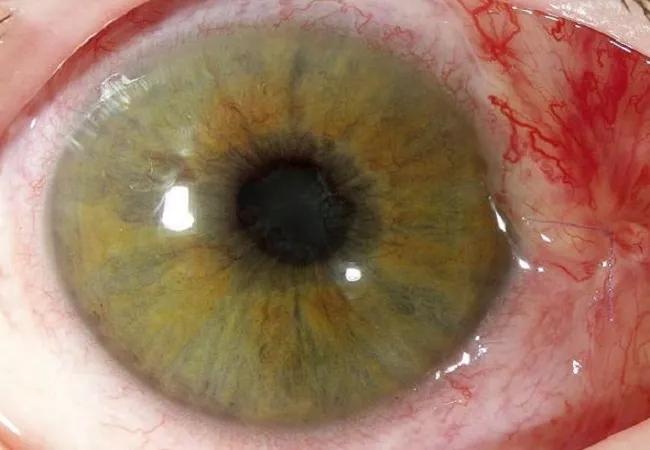New research sheds light on mechanism of action in ROP protection

The transcription factors known as hypoxia-inducible factors (HIFs) are oxygen sensors in the cellular environment.
Advertisement
Cleveland Clinic is a non-profit academic medical center. Advertising on our site helps support our mission. We do not endorse non-Cleveland Clinic products or services. Policy
In a hypoxic setting, such as the womb during embryogenesis, HIFs mediate the adaptive response to reduced oxygen availability. They direct the expression of genes vital to survival and development, including those promoting erythrocyte production and regulating fetal retinovasculature formation.
In hyperoxic conditions, such as the high-oxygen concentration needed to support premature infants’ breathing, HIF activity is downregulated and normal blood vessel growth is inhibited, leading to the vasoproliferation of retinopathy of prematurity (ROP) and potential blindness.
The class of drugs called HIF stabilizers prevents HIF degredation and thus has shown promise in preventing ROP and treating anemia secondary to chronic kidney disease (CKD). But HIF stabilizers’ mechanism of action has raised concerns that they might exacerbate pathologic retinal angiogenesis (neovascularization) associated with ROP or diabetic retinopathy in CKD.
Cleveland Clinic Cole Eye Institute researchers tested that premise, using the HIF stabilizer roxadustat in a mouse model. In results presented at the 2019 Association for Research in Vision and Ophthalmology annual meeting, George Hoppe, MD, PhD, and colleagues reported that administration of roxadustat during hyperoxia does not result in pathological angiogenesis, and instead effectively prevents oxygen-induced retinopathy (OIR). The research also revealed more about the molecular pathways by which HIF stabilization works and how it should be therapeutically used.
Advertisement
When premature babies are placed in high-oxygen environments, their still-developing retinas are protected by choroidal circulation. However, when infants leave this environment, hypoxia causes their retinal tissue to become ischemic. The central element of the body’s response to hypoxia is upregulation of HIFs.
“HIFs are responsible for transcription of hundreds of genes,” Dr. Hoppe says. “They stimulate blood vessel growth, affect cytoprotection and cytostability, and reduce mitochondrial restoration.”
Abnormal HIF upregulation leads to preretinal neovascularization, he explains. These disorganized, pathological blood vessels are extremely fragile and can lead to fibrovascular scarring on the retina, a major cause of retinal detachments and retinal hemorrhaging in infants.
The most common treatment for neovascularization is laser surgery to obliterate the tissue, he says. However, this also destroys peripheral tissue, often leaving only central vision. Dr. Hoppe and his collaborator, ophthalmologist Jonathan Sears, MD, have worked for more than a decade to find ways to intervene during the hyperoxic phase and prevent neovascularization. Their work has repeatedly pointed them to HIFs.
HIFs’ alpha subunits are critical to the transcription factors’ oxygen-dependent regulatory capabilities. The alpha units are hydroxylated at conserved proline residues by HIF prolyl-hydroxylases, allowing for recognition and targeting for rapid degradation in normoxic or hyperoxic conditions. Degradation of subunit HIF-1α results in halted downstream angiogenic pathways, including the reduction of vascular endothelial growth factor (VEGF) secretion associated with oxygen-induced vascular obliteration. HIF-2α regulates a variety of hypoxia-inducible genes during embryonic development, including those involved in erythropoiesis and angiogenesis.
Advertisement
HIF stabilizers such as roxadustat act by inhibiting prolyl hydroxylase enzymes, preventing HIF degradation.
In the retina, pathologic angiogenesis is mediated by Müller cell macroglia. Dr. Hoppe and his colleagues tested whether Müller cell HIF-2α activation was necessary for HIF stabilization-induced prevention of OIR, so that they could determine whether roxadustat activates pathologic angiogenesis.
To carry out the investigation, the Cole Eye Institute researchers used mice with a knockout of HIF-2α in their Müller cells. The researchers subjected the knockout mice to 75 percent oxygen from day 7 to day 12 of their lives and intraperitoneally injected them three times with either phosphate-buffered saline or roxadustat at days 6, 8 and 10. At day 17 their retinas were stained and areas of vaso-obliteration and neovascular tufting were measured; retinal HIF protein and gene expression levels also were assessed.
The results showed that systemic roxadustat administration during hyperoxia prevented OIR. The drug primarily upregulated HIF-1α in mouse retinal tissue. Retinal HIF-2α levels increased by 50%, but retinal expression of HIF-2 α targets that are known to promote angiogenesis and endothelia cell migration did not increase. When wild-type non- HIF-2α-knockout mice were treated with HIF stabilization after ischemia developed, vascular loss and neovascularization increased.
Dr. Hoppe and his colleagues had hypothesized that elimination of the HIF-2α subunit from the mice retina would prevent roxadustat from blocking neovascularization, demonstrating that the HIF-2α pathway is important for the drug’s action.
Advertisement
“We actually saw quite opposite,” Dr. Hoppe says. “We didn’t see exaggerated angiogenesis. We didn’t see the drug stop working. In fact, it worked even better.
“That was kind of a defeat, because we couldn’t implicate HIF-2α in the action of the drug,” he says. “But it was good news for the pharmaceutical company that is now conducting clinical trials, and good news for patients overall.”
Roxadustat is currently in phase 3 clinical trials for the treatment of chronic anemia related to kidney disease.
While the Cole Eye Institute Research showed that roxadustat administration does not lead to pathological angiogenesis, and that HIF-2α stabilization isn’t required for vasoprotection and OIR prevention, HIF-2 α upregulation could exacerbate existing neovascularization and vasoobliteration. That reinforces the need to use HIF stabilization to prevent ischemia, not react to it, Dr. Hoppe says.
Advertisement
Advertisement

First full characterization of kidney microbiome unlocks potential to prevent kidney stones

Researchers identify potential path to retaining chemo sensitivity

Large-scale joint study links elevated TMAO blood levels and chronic kidney disease risk over time

Investigators are developing a deep learning model to predict health outcomes in ICUs.

Preclinical work promises large-scale data with minimal bias to inform development of clinical tests

Cleveland Clinic researchers pursue answers on basic science and clinical fronts

Study suggests sex-specific pathways show potential for sex-specific therapeutic approaches

Cleveland Clinic launches Quantum Innovation Catalyzer Program to help start-up companies access advanced research technology